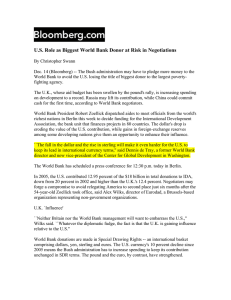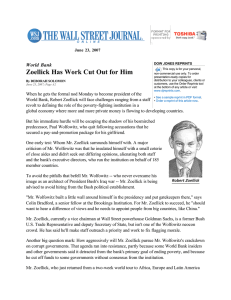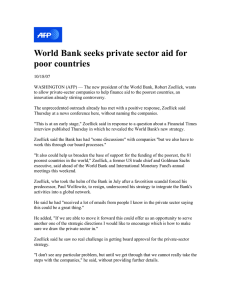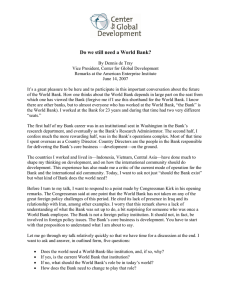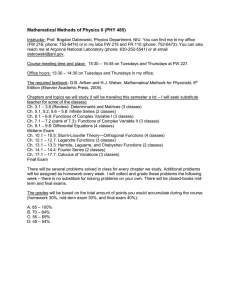Intercultural Awareness Essay: Communication Styles Analysis
advertisement
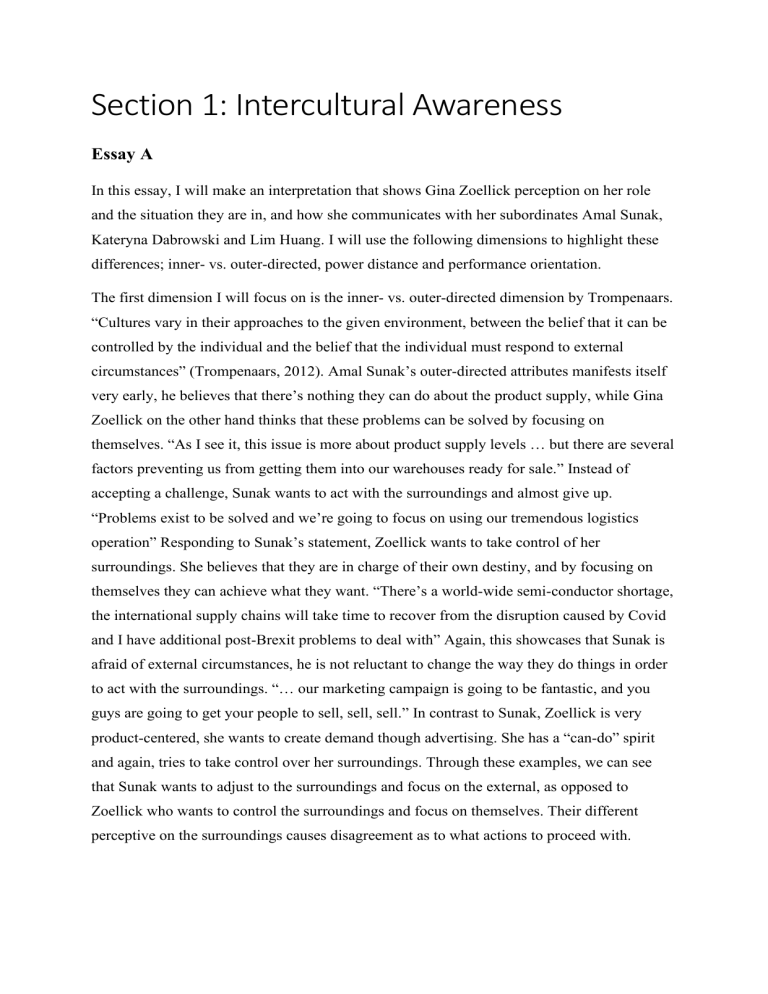
Section 1: Intercultural Awareness Essay A In this essay, I will make an interpretation that shows Gina Zoellick perception on her role and the situation they are in, and how she communicates with her subordinates Amal Sunak, Kateryna Dabrowski and Lim Huang. I will use the following dimensions to highlight these differences; inner- vs. outer-directed, power distance and performance orientation. The first dimension I will focus on is the inner- vs. outer-directed dimension by Trompenaars. “Cultures vary in their approaches to the given environment, between the belief that it can be controlled by the individual and the belief that the individual must respond to external circumstances” (Trompenaars, 2012). Amal Sunak’s outer-directed attributes manifests itself very early, he believes that there’s nothing they can do about the product supply, while Gina Zoellick on the other hand thinks that these problems can be solved by focusing on themselves. “As I see it, this issue is more about product supply levels … but there are several factors preventing us from getting them into our warehouses ready for sale.” Instead of accepting a challenge, Sunak wants to act with the surroundings and almost give up. “Problems exist to be solved and we’re going to focus on using our tremendous logistics operation” Responding to Sunak’s statement, Zoellick wants to take control of her surroundings. She believes that they are in charge of their own destiny, and by focusing on themselves they can achieve what they want. “There’s a world-wide semi-conductor shortage, the international supply chains will take time to recover from the disruption caused by Covid and I have additional post-Brexit problems to deal with” Again, this showcases that Sunak is afraid of external circumstances, he is not reluctant to change the way they do things in order to act with the surroundings. “… our marketing campaign is going to be fantastic, and you guys are going to get your people to sell, sell, sell.” In contrast to Sunak, Zoellick is very product-centered, she wants to create demand though advertising. She has a “can-do” spirit and again, tries to take control over her surroundings. Through these examples, we can see that Sunak wants to adjust to the surroundings and focus on the external, as opposed to Zoellick who wants to control the surroundings and focus on themselves. Their different perceptive on the surroundings causes disagreement as to what actions to proceed with. Secondly, I will focus on their perception of their role and how they should behave by using the Power distance dimension by Hofstede. “Power distance is the extent to which the less powerful members of institutions and organizations within a country expect and accept that power is distributed unequally” (Hofstede, 2010). Gina Zoellick and Lim Huang believes in high power distance, whereas Kateryna Dabrowski and Amal Sunak believes in low power distance. “Before anyone else could say anything, their Zoom session had been ended by the CEO.” Here we can clearly see that Zoellick wanted the last word, by not letting anyone else speak before she ended the meeting. “What is the point of this exercise Gina?” Dabrowski dares to speak up and question her superior, she does not refer to Zoellick by her title and seeks two-way communication. “It is a sign of our honourable President’s confidence in us” Huang, on the other hand refers to her title and shows his respect. He waits until the end until he speaks and never question her authority. “… I think –” “Amal” said Zoellick sharply. Zoellick shows her superiority by interrupting Sunak, she does not want to be questioned and believes that she is entitled to respect. “And the whole problem has been made worse as a consequence of your insistence two years ago that we had to take all the buffer stocks out of the supply chain” Amal also dares to speak back to Zoellick and questions her previous decisions. After presenting these examples, we can see that Zoellick wants to take the decisions and take control of the conversation. Huang clearly does not mind this and tolerates these actions as opposed to Dabrowski and Sunak. They want to be heard and see everyone as equal. Lastly, I want to focus on GLOBE’s dimension about performance orientation. “Performance orientation reflects the extent to which a community encourages and rewards innovation, high standards and performance improvement” (GLOBE, 2004). Gina Zoellick and Lim Huang is focused on high performance orientation, whereas Amal Sunak and Kateryna Dabrowski showcases low performance orientation. “So listen up people, it’s a competitive world, and I want to know which one of you is going to increase your sales forecast for 2022 by 25%, and demonstrate that you are the winner.” We can see that Zoellick wants people to work hard to succeed, and that good results are valued highly. “I, for instance, have had a close family member who needed my care.” Sunak, on the other hand values his family life higher and does not want to work as hard. “Perhaps we could proceed with the current forecasts, Madam President, but all countries can commit to revising their overall forecasts for 2022 by the end of the first quarter, 31 March 2022?” Huang does not mind competitive work environment and strives to improve. “…but if you would rather that we all enter into a competition to provide you with wildly optimistic and unrealistic targets” Dabrowski clearly wants to set lower performance targets. By looking at these examples we can clearly see that Zoellick and Huang does not mind competitive working environment, while Sunak and Dabrowski is the opposite, they value family and lower performance targets. In conclusion, I have tried to illustrate why everyone perceive this issue differently. Their different perception on how to resolve issues, how to act and set targets causes disagreements in this meeting. Using different dimensions made it easier to understand why people act like they do, and how people react to different situations. Word count: 982 References Hofstede, G. H., Hofstede, G. J., & Minkov, M. (2010). Cultures and organizations: Software of the mind: intercultural cooperation and its importance for survival (3rd ed). McGraw-Hill. House, R. J., & Global Leadership and Organizational Behavior Effectiveness Research Program (Eds.). (2004). Culture, leadership, and organizations: The GLOBE study of 62 societies. Sage Publications. Trompenaars, F., & Hampden-Turner, C. (2012). Riding the waves of culture: Understanding diversity in global business (Rev. and updated 3. ed). Brealey. Section 2: Ethical Awareness BUSINESS REPORT To: MARIE ULSETH, CEO OF NORWEGIAN SEAFOODS From: JO JENSEN, ADVISOR NORWEGIAN SEAFOODS Subject: ESTABLISHING A NEW FISH-FARMING FACILITY Date MONDAY 29TH NOVEMBER 2021 CC: ___________________________________________________________________________ Introduction The aim of this report is to analyse the consequences of establishing a closed- or open-sea facility at Kvitneset. I will consider our most important stakeholders and recommend which one we should establish. 1. Stakeholders There are several stakeholders we must consider when analysing the situation we have at hand. The six stakeholders we must prioritize the most are: - Our owners - Our employees - Our suppliers - The local municipality - Fishermen - The cabin owners 2. Consequentialist analysis for the stakeholders There are different consequences for the stakeholders. I believe that this dilemma should be solved by choosing what gives the most amount of good, to most amount of people. Opening a new facility would be a profitable investment and would benefit our owners. It would also benefit our current and new employees, suppliers to the new facility, and the local municipality (because more people are moving into the area). On the other hand it could annoy fishermen and cabin owners, depending on if we choose an open- or closed-sea facility. 3. Consequences closed-sea facility vs. open-sea facility Establishing a closed-sea facility would be far more costly because of electricity and power grids, but more sustainable and would solve problems linked to interbreeding and lice. It would also cater to fishermen who are concerned about changes to the local indigenous life. The noise levels might be irritating for some locals and cabin owners in the area. Establishing an open-sea facility would not be as costly as a closed one, but the fact that Fiskeridirektoratet has indicated that all new fish farms ought to be closed by 2030 might be more expensive in the future. A big negative is the alterations of the genes of wild salmon, the high level of lice infection, which causes the salmon strong discomfort. It might also damage the marine ecosystem in the area. 4. Conclusion and Recommendation After considering our most important stakeholders and the different consequences between open- and closed-sea facility, I have decided to recommend that we establish a closed seafacility. Jo Jensen Advisor at Norwegian Seafoods Word count: 376
